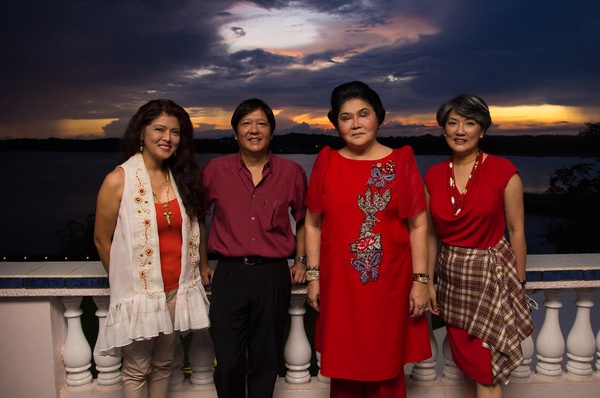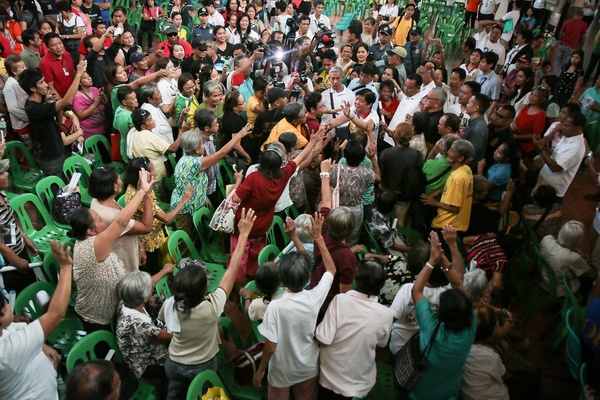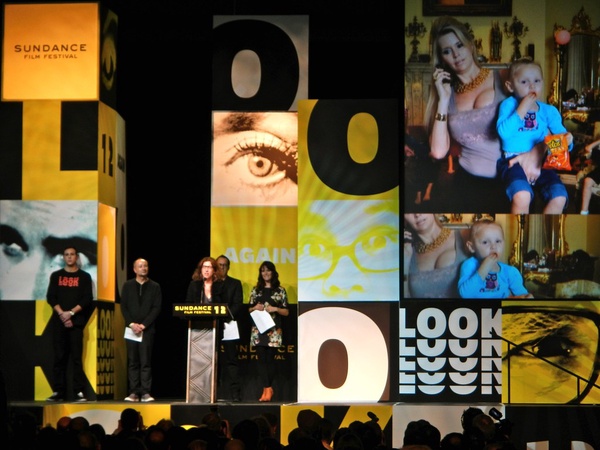Lauren Greenfield has long displayed an ambiguous stance toward her subject matter. As photographer and then documentarian of the rich and trashy, including the likely next president of the Philippines, Greenfield has created a body of work that stands simultaneously as exposé and spectacle.
From her first photo book, Fast Forward: Growing Up in the Shadow of Hollywood (1997), Greenfield captured the materialist decadence of the elite and the ambitious with strobe lighting that both flattered and exposed. From 2002-2009, Greenfield was a member of VII Agency, whose illustrious photographers split their time between hard-hitting warzone journalism and glossy celebrity portraits for lifestyle magazines. Her photographic style mixed the freak-show voyeurism of Diane Arbus with the satirically deadpan visual commentary on consumer culture of Martin Parr. The nipped and tucked trophy wives, fur-coated limousine magnates, and pre-teen beauty pageant contestants were simultaneously grotesque and enviable.
This is perhaps the secret to her ability to continually get past security and publicity gatekeepers to secure intimate access to her exclusive subjects. Even the images that show their ugly debauchery and self-destruction are monuments to their status.
Greenfield’s career as a filmmaker grew directly out of her photography work. Her first documentary feature, Thin (2006), was the companion to a photo book of the same name that profiled Florida women struggling with eating disorders.
Greenfield’s subsequent trilogy of films–The Queen of Versailles (2012), Generation Wealth (2018), and The Kingmaker (2019)–focused on the central interest of her career: the self-presentation of the ultrawealthy. Across the three documentaries, we see Greenfield, who majored in anthropology, oscillate between a fetishization of the ritual and rites of capitalism and a critical stance toward the structural inequality and violence of that same system.
The Queen of Versailles
A family portrait of David and Jackie Siegel as the 2008 financial crisis sinks their ambition to build the largest house in America in knockoff Louis XIV style, The Queen of Versailles is classic Greenfield. She is content to observe them at work and play with no voiceover narration and minimal non-diegetic speech or on-screen text to explicitly contextualize or interpret the Siegel’s drama. Staged photo ops are turned into keen but understated observations of the absurdity of image-making as Jackie, a Rochester computer engineer turned Florida model and socialite, delightedly poses for Greenfield in front of and atop various marble, velvet, oil paint, and gold-plated objects. With the moving image–even better than with her still photography–Greenfield manages to simultaneously capture the spectacle that Jackie desires and the backstage efforts and mess behind it. We see tired Filipina nurses straining in the corner of the frame to hold up lamps to highlight Jackie’s hair and wrangling the Siegels’ many children in the background. We see the designer dogs that pose for photos in Jackie’s lap shitting on the mansion floor.
The façade of limitless wealth comes crashing down when it turns out that David was just as addicted to cheap, unsustainable loans as the suckers his company pressures into buying Las Vegas timeshares. Jackie struggles to rein in her expenses–though she cannot resist adding to her kids’ piles of neglected bicycles and pets when Christmas comes around–and the marriage becomes more transparently loveless as David obsesses over the loss of money that seems to be his only measure of self-worth. With the banks closing in and no solution but bankruptcy in sight, they may even have to sell off Versailles. “The bailout was supposed to help the common people—us,” Jackie complains to Greenfield.
This latter part of the film relies more heavily on sit-down interviews. The Siegels keep us entertained with absurd self-pitying soundbites, though we also get hints that this stylistic change may be due to Greenfield losing access: David is increasingly impatient with her, and in one scene the camera visibly hesitates to even enter the room where he sits in angry contemplation. The exchange of access for publicity is no longer a good deal for Greenfield’s subjects when their pride turns to shame.
Perhaps because of its timing after the housing bubble burst, and before David Siegel came back out on top with a renewed aura of financial invincibility and a direct line to President Trump, The Queen of Versailles offers a more direct and trenchant attack than Greenfield’s preceding work on the rich and famous, a clear indictment of the hubris and greed that turned the US housing market into a pyramid scheme. Whereas other subjects reveled in the attention that Greenfield brought them, the Siegels were unhappy enough with their representation to file a series of spurious lawsuits against Greenfield in the years that followed the film’s release.
Over the past year, and after negotiations for Jackie to join the “Real Housewives of New York” on Bravo TV fell through, the Siegels have reportedly been shooting a new reality show of their own. The TV series will document the final 2022 completion of the still-under-construction “Versailles” mansion, in a presumably more positive and controlled light than Greenfield captured.
Generation Wealth
Greenfield herself is far more present as a character and narrator in Generation Wealth. In a mix of memoir and broad reflection on how people value and sell themselves, Greenfield revisits the rich kids, porn stars, financiers, and plastic surgery addicts she photographed over the decades. Some of her subjects went from rags to riches back to rags (or at least to disappointing middle-class existence); others just went from rich and cocky to rich and sad. The film is global in scope, bringing us beyond the United States to the homes of Russian oligarchs and Chinese nouveau riche (the subject of Bling Dynasty, a miniseries that Greenfield directed for GQ magazine’s website between The Queen of Versailles and Generation Wealth), to show that Americans are no longer the only ones trying to buy their way to happiness or infatuated with leopard print and silicone.

In an effort to fill in the macro-level context and explicit critique missing from her previous work, Greenfield trots out journalist Chris Hedges as a prophet of doom. Hedges tells us that all the decadence and excess just show that our society is on the brink of collapse, though Greenfield dodges Hedge’s socially progressive implication. When Hedges says civilization is in decline, he is talking about poverty, environmental degradation, and the loss of an ethos of collective responsibility. After Greenfield creatively edits Hedges’ proclamations together with montages of rich people being vulgar and narcissistic, “civilization” takes on the alternative meaning of good taste and modesty to bourgeois standards.
Hedge-fund-manager-turned-most-wanted-fugitive Florian Homm, who doubles as a poster boy of avarice and our economics expert, also gestures vaguely to low interest rates, the end of the gold standard, and television’s effects on culture as producing a get-rich-quick global system of conspicuous consumption. But it is the spectacle of consumption and ambition, not its structural causes, that most interests Greenfield. Nobody talks about economic deregulation or the decline of progressive taxation as drivers of rising instability and inequality. Greenfield’s investigation remains fixedly at the level of personal moralizing, and so follows the same neoliberal logic of individual responsibility over public policy or structural reform that lies at the heart of the system that Generation Wealth sets out to critique.
We meet Greenfield’s own family and learn that she has much in common with her subjects in the sense of ambition and pressure to succeed (though they adhere to the less gaudy taste of middle-class intelligentsia–a difference reinforced by her choice to film scenes in the family home handheld with no professional lighting). She also reflects on her own role as an image-maker helping to create the spectacle: “I was both a critic and a participant,” in the world of her subjects, she tells us in voiceover narration. The insight that she shares a world with the depraved and parasitic elite fails, however, to lead Greenfield toward structuralist self-criticism and progressivism. To the contrary, the film turns in the end toward conservatism.
Generation Wealth concludes with a series of personal salvation stories, in which the rich and criminal lament their misguided pursuit of money and discuss how they found true enlightenment and self-realization in parenthood and comfortable but not excessive bourgeois existence (with no mention of all the people they trampled on the way up or of how money served as a get-out-of-jail-free card whenever they got into trouble). Her subjects find happiness only in “reverting” to their “roots”: family, religion, hard honest work.
If The Queen of Versailles taught us that the rich are no better than us, Generation Wealth teaches us that they are no worse, and that privilege is as difficult a cross to bear as poverty. In a particularly tone-deaf sequence, Greenfield laments the tremendous expectations her sons must suffer under because both of their parents, and at least two of their grandparents, are Harvard alumni. The viewer cannot help but feel that the preferential admissions status her boys will enjoy in a few years is nothing if not just reparation for the burden of legacy they must bear.
The Kingmaker
Greenfield’s latest and best film is set in the Philippines and recounts the past excesses and present machinations of Imelda Marcos, widow of kleptocratic former president Ferdinand Marcos. The Kingmaker shuttles back and forth between an account of Imelda’s tenure as first lady from 1965-1986 and her 21st-century attempt to make a political comeback as the puppeteer of her mediocre son Bongbong (Ferdinand Jr.), who runs for vice president in the film. Bongbong, despite his lack of charisma or ideas but with help from an online disinformation campaign whitewashing his personal and family past, has since emerged as the frontrunner candidate in the country’s May 2022 election, running in alliance with current President Rodrigo Duterte’s daughter Sara.

As Imelda orchestrates the Marcos’s political comeback, we see that she shares the vapidly gilded interior design and sartorial taste of Greenfield’s American subjects. Unlike them, though, she is intent on convincing us of her altruism and devotion to public service as the mother of the nation. In trademark Greenfield style, we are treated to moments that turn the former first lady’s image management against her and puncture the façade of caring and grace, as when Imelda knocks over framed photos of herself with foreign dignitaries and leaves her assistants to pick up the broken shards. Greenfield turns the camera to those servants as Marcos continues recounting her glorious diplomatic exploits without missing a beat.
Notwithstanding such adroit scenes of observation, The Kingmaker relies more heavily on historical archival materials and a combination of voiceover and sit-down interviews than Greenfield’s previous work. There is more context, more explanation. In contrast to the political discretion of her previous films, power and violence are inescapable when talking about the Marcos clan. Whereas the American plutocrats of Greenfield’s other photo and film projects merely profited from and perpetuated a system with a dark side of mass evictions, systemic racism, and a public health crisis, the harms Imelda has inflicted are more direct. She stole billions from taxpayers, displaced villagers to make room for her open-air island zoo of African fauna, ordered the assassination of her political rival and torture of rights activists. Greenfield foregrounds those victims and the historical context of the Marcos’ wealth with a force absent in her previous work.

Part of the reason for this stylistic shift from more passive showing to more active telling may lie in the change of geographic focus. Whereas Greenfield might–correctly or not–have assumed that her audience would understand something of the sociopolitical subtext of her images of Jackie Siegel or Limo Bob, she could make no such assumption that the same audience would remember anything of Imelda Marcos beyond perhaps her shoe collection. This distance between subject and audience forces exposition, and Greenfield is a deft enough storyteller to incorporate a clear, well-documented indictment of the former first lady without ever straying far from her wheelhouse of images of jaw-dropping excess and arrogance. Greenfield renders the Marcos family understandable but not sympathetic; the violent threat they pose to the Philippines is clear. Contrary to the today-popular notion that insiders are best positioned to tell their own people’s stories, Greenfield’s edge as a critical observer is sharpest when she is not a participant sharing her subjects’ world.
Documenting the New Gilded Age
Wealth and income inequality are on the rise across much of the world. Calls for progressive reform compete with nationalist retrenchment and xenophobic scapegoating as responses to the ravages of crony capitalism. The American Republican Party has become a servant to the Greenfieldian villain Donald Trump and his brand of mendacious showmanship and winner-take-all-ism. The politics of wealth have not been so explicit since perhaps the court of the Sun King.
Lauren Greenfield is no revolutionary. She has always been a brilliant documentarian of elite culture and materialism, but has rarely voiced objection to their impacts on society. That is, quite likely, why she still gets access to the rich and famous and receives commissions for magazine covers.
There are other ways to document the elite. Michael Moore gains access through ambush, if not to unguarded moments of their intimate personal lives than to forced interactions that hold the rich and exploitative to account, or at least make them squirm. Adam Curtis finds Greenfield-esque moments in which masks slip and the unstated becomes manifest, but he does so not through the seduction of visual flattery but by combing archival footage for outtakes and decontextualized images that he remixes with a voiceover that tells us exactly what to think about the structural and ideological roots of injustice.
The Kingmaker is Greenfield’s most expressly political and prescriptive project to date, going beyond the spectacle to grimly show the real world that the spectacle both covers up and parasitizes. It remains to be seen whether that latest film marks the start of a new, more justly judgmental phase in her career, or if she will return to the coy ambiguity of her earlier work, holding up a mirror to the elite and letting viewers decide whether to revolt or envy.
Noah Amir Arjomand is the author of Fixing Stories: Local Newsmaking and International Media in Turkey and Syria, coming from Cambridge University Press in February 2022. He is also a documentary filmmaker and photographer; his first feature film, Eat Your Catfish, premiered at the International Documentary Film Festival Amsterdam in November 2021. He is currently a postdoctoral scholar at Indiana University and holds a PhD in sociology from Columbia University.

